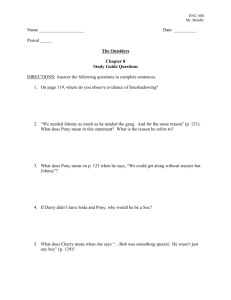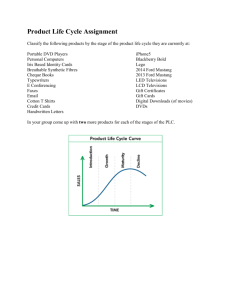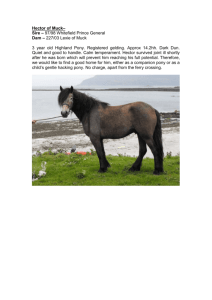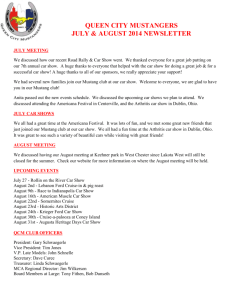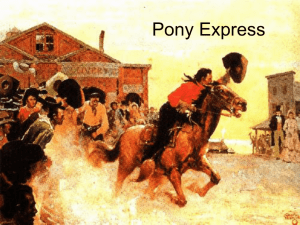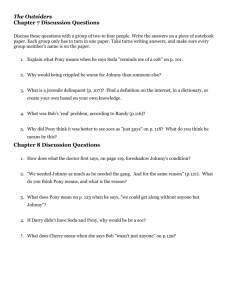The Pony Class
advertisement
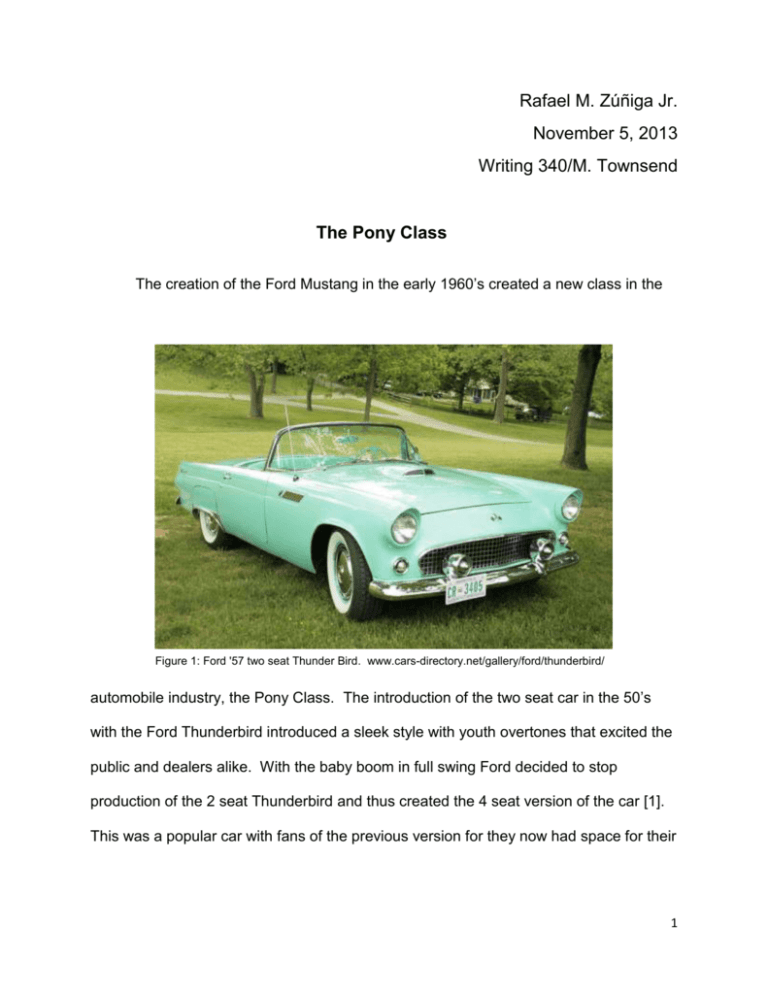
Rafael M. Zúñiga Jr. November 5, 2013 Writing 340/M. Townsend The Pony Class The creation of the Ford Mustang in the early 1960’s created a new class in the Figure 1: Ford '57 two seat Thunder Bird. www.cars-directory.net/gallery/ford/thunderbird/ automobile industry, the Pony Class. The introduction of the two seat car in the 50’s with the Ford Thunderbird introduced a sleek style with youth overtones that excited the public and dealers alike. With the baby boom in full swing Ford decided to stop production of the 2 seat Thunderbird and thus created the 4 seat version of the car [1]. This was a popular car with fans of the previous version for they now had space for their 1 young families. Following the introduction of the 4 seat Thunderbird, Chevrolet Figure 2: 1960 4 door Chevy Corvair www.curbsideclassic.com/automotive-histories/automotive-history-19601963chevrolet-corvair-gms-deadliest-sin/ introduced the Corvair [2]. This new car introduced the American auto industry to what would become a standard in cars, the bucket seat and floor mounted transmission shifter. These two main components ushered in what would be known as the start of the Pony car era. The Pony car had many distinct qualities that made it stand out among other cars of the 1960’s and 1970’s. Throughout this era there were many cars that wanted to compete against the Mustang and many came close, but they never reached the pinnacle that the Mustang reached. Though the competition at home was fierce there was competition from overseas as well. This competition came primarily from Japan with the introduction of the Toyota Celica [3]. With the passage of time these cars 2 started to grow in size and they lost the sporty look the class was so famous for. The end of an era came with the passage of new governmental environmental laws and the oil embargo of the early 70’s. The class managed to survive through the last decades of the 20th century with the introduction of several new models including the redesigned Mustang. As the 21st century began Ford paid homage to the pony car by redesigning the 5th generation Mustang to look like the original pony car. The Ford Mustang is said to have been designed by Lee Iacocca, one of Ford’s chief engineers. However, in reality he was the one that spearheaded or supervised the design of the car and was instrumental in inspiring the teams to design the car. In the end the winning design did not come from the Ford team rather from the LincolnMercury division team [2]. Through interviews it is now known that it was designed during a design charette with several design teams from the Ford Motor Co. The car that would become the Mustang started out as the T-5 project. This project was to last a record 18 months to come up with a design and a drivable car [2]. The car started out as a two person car with a center mounted engine that in the end looked like the Pontiac Fiero of the 1980’s. The team worked on the concept car for many weeks and in the end they used the base of the Falcon for the new design. . The concept car was formally introduced at the US Grand Prix in Watkins Glenn New York in 1962 [4]. During its debut the car was tested in a Formula One race track where it almost beat the top Formula One cars of its day. Following this debut the design team had other changes in mind including its name. John Najjar Ferzely, an executive at Ford and avid fan of the WWII Mustang P-51 fighter plane highly 3 recommended the name for the new car [5]. Figure 3: North American P-51D Mustang aircraft. Kevin Whitehead - Jetwash Images www.airliners.net Then Ford CEO, Henry Ford II wanted the car named T-Bird II. However others in the design team would not hear of it and several names were tested in focus groups along with Mustang to see which name would be used. In the end the name that won all focus group polls was that of Mustang. Though the mechanical systems were from the Falcon the overall look of the car was completely redesigned. 4 Ford created the Pony class with the introduction of the Mustang. Though the Chevy Corvair a few years before introduced the use of bucket seats and the floor Figure 4 - Floor mounted transmission shifter. www.dealsonwheels.com mounted transmission shifter (see picture above). With the introduction of the Chevy Corvair Ford introduced the Futura with the base of the Falcon. However the design team at Ford particularly Lee Iacocca saw a great opportunity to design a better car that would appeal to youth and would be cheaper to produce. With the introduction of the Mustang the Pony class was defined forever [3]. 5 This class of automobiles was sports-like with large front hoods and rather small rear compartments. One of the key features asked for an open mouth or an exposed grill where lights and emblems were placed like the running pony. Another trademark of the class was the base price of the cars. The price for these cars had to be under $2500 (in 1965 dollar value) [2]. The car usually consisted of a V6 engine though the car could be customized with a larger V8 engine. This was the beauty of the Pony class which allowed the buyer to upgrade the car to their taste. They could ask for a larger engine, radio, four speed manual transmission and even an AC (*). The great thing about these upgrades was that the price was about 60% more for the upgrades from the original price. The flexibility of the upgrades and the wide appeal of the car enticed other car manufacturers to design a pony car to compete against the Mustang. Most of these cars had to be two door cars and be able to seat 4 persons. The auto companies also had to target the youth of the day with massive advertising campaigns both on television and the print media. These cleaver campaigns not only brought out the youth but also the young at heart to the dealers to purchase these new sporty cars. 6 Figure 5: 1964 Plymouth Barracuda. http://www.motor-vision.co.uk/latest-news/cars/the-fordmustang-is-galloping-towards-to-europe/ The original Mustang created not only the Pony Class of cars but it also paved the way for the competition to enter their own versions of the Pony Class. In the beginning there was the Plymouth Barracuda that went on sale 15 days before the Mustang went on sale for the first time [1]. Though Plymouth/Chrysler knew of the Mustang they went ahead and released the Barracuda. This lack of attention to the overall design of the car would have created the “Fish Car” had the Barracuda been a big hit [2]. In part this was due to the tough economic times Chrysler was going through at the time. Instead, the Mustang was an enormous hit outselling even the Ford executive’s projections of 100,000 units by years end. After selling more than 600,000 units within its first six months other car companies took notice and entered the Pony car race. The following year (1965) 7 General Motors brought back the Corvair as a four seat version of the two seat model. Then Pontiac came into the race with the introduction of the Firebird and Mercury (part of the Ford Motor Co.) introduced the Cougar with a Mustang base. The only car to come close in redefining the Pony class was the AMC (American Motors Corporation) Figure 6: AMC Javelin the only pony car that came close to dethroning the Mustang. http://flipcars.com/cars/amc/amc-javelin/photos.html#.Unt0dS_TmM8 Javelin [6]. The following year the AMC’s AMX 2 seat car is introduced at Daytona where the car stirs up the fans with its new sleek look and fast engine [6]. The last car to enter the pony race was the Camaro by Dodge. This was a larger version of the Barracuda and the beginning of the end of the pony class of cars. With the introduction of the Chevy Camaro the pony cars began to transform into muscle cars. The oil embargo of the early 70’s and the clean air act only helped to fuel the end of the pony class. As the years passed the pony car started to lose the luster it once had. The cars instead of retaining the features that made it so popular started to get bigger by the year. The size of the body of the cars and the engines just got bigger 8 and bigger. The pony customer base steered away from the larger cars for other domestic or foreign cars that were smaller and had better gas mileage (this sounds familiar with the introduction of the gas guzzling SUV’s of the late 1990’s). For this main reason the Japanese automakers won over the American car companies with their smaller compact cars that used less fuel. Interesting to say but the muscle cars of the 1970’s were popular with the public though the buyers of these cars were collectors or people that loved to race these vehicles. The muscle car version of the Mustang continued to get bigger and offered more amenities to the customer. The larger versions of the car offered bigger V8 engine blocks, though these huge engines only added to the overall size and weight of the car. For example, the ’73 version of the Mustang added almost 9 inches to the original length and about 6 inches to the width [5]. With the bigger engines came the need for safety and the redesign of the car itself. This only meant that the details of what made the pony car so desirable were now being lost to the bigger equipment. With the bigger engines the cars got heavier as well. This meant that the suspension, breaking systems and tires had to be much larger than the previous generations. In the end the Challenger, Barracuda and the Javelin models were canceled [3]. Both the Camaro and the Firebird almost went the same way though they were given a final opportunity to live on. The Mustang itself was almost dead though it was resurrected with the Mustang II model. This version of the car was smaller and fuel efficient. At the same time companies from abroad entered the race with their versions of the Pony car. Toyota entered the race with the Celica in both a V4 & V6 engines in 9 Figure 7: 1970 Toyota Celica. http://marlincar.com/toyota-celica-1970 1970 (see figure 7). This model was of particular interest since it looked quite much like the ’68 Mustang and was a few inches shorter [7]. The differences between the cars were that the Celica was very practical but had no personality. The car also suffered from using a smaller engine rather than offering a larger V8 engine like its American counterparts. However, the reason behind the smaller engines was that the Japanese government heavily taxed the car manufacturers that used engines above 120 cubic inches. In the end Japanese car makers would dominate the American road with their fuel efficient vehicles. The future of the pony car seemed like it was long dead and buried. Though what saved the class were the General Motors versions of the class in both movies and TV shows of the day. The popularity of the TV shows like The Rockford Files and Night Rider gave American car companies hope and were able to introduce new versions of the pony cars [3]. One of these new cars was the Mercury Capri that appeared in 1980. This car was a twin of the Mustang of the day. During the 80’s the lone three survivors of the pony car era, Mustang, Firebird and the Camaro reemerged with popularity. This factored in with fuel efficiency and high performance engines. 10 After barely surviving the SUV craze of the 1990’s and early 2000’s Ford decided to pay homage to the Pony car of the 60’s in the 5th generation of the Mustang. With the popularity of the 5th generation other American companies took a hard look and reintroduced both the Camaro and the Challenger to rave reviews and sales [8]. In the end the remnants of the pony cars could still be seen in the cars of today. The long front hoods and small trunks are seen in both domestic and import cars. 11 Bibliography [1] B. Cannon, Mustang: Forty Years, North Olmstead: Advanstar Communications, INC, 2004. [2] R. Fria, A Mustang Genesis: The creation of the pony car, Jefferson North Carolina: McFarland, 2010. [3] "Pony Car," Wikipedia, the free encyclopedia, 28 September 2008. [Online]. Available: http://en.wikipedia.org/wiki/Pony_car. [Accessed 2 October 2013]. [4] Anonymous, "Mustang Grazing?," Ward's Auto World, vol. 41, no. 5, p. 8, 2005. [5] B. McMahon, "Mustang Power& Passion," The Courier Mailer, p. CO5, 21 April 2004. [6] M. DeLorenzo, "Ford Mustang at 40," Road & Track, vol. 55, no. 9, p. 102, 2004. [7] K. S. Hays, "A Brief History of the Ford Mustang," County Living, vol. 32, no. 10, p. 34, 2009. [8] J. Lippert, 25 February 2013. [Online]. Available: www.automoblog.net. [Accessed 5 October 2013]. [9] M. Hanjora, "Brief: 1966 Ford Mustang," McClatchy - Tribune Business News, Washington DC, 2013. [10] J. Halliday, "Mustang," Advertising Age, vol. 76, no. 45, p. S12, 7 November 2005. [11] "North American P 51 Mustang," Wikipedia - the free encyclopedia, 26 April 2007. [Online]. Available: http://en.wikipedia.org/wiki/P-51_Mustang. [Accessed 2 October 2013]. 12

